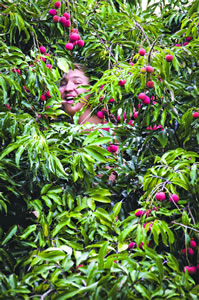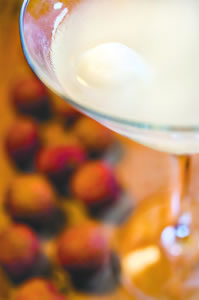Love Affair With Luscious Lychee
Olana Organic Farm is a three-acre permaculture farm dedicated to building sustainable agricultural systems.What’s growing now: avocado, basil (Thai, Italian, lemon), beets, carrots, celery, chard (Swiss, rainbow), chives, cilantro, fennel, ginger, kale (curly), lime, (kaffir), mint, onions (red and white sweet bulbing), pak choi, lychee, mango, papaya (sunrise), parsley (Italian, curly), pea shoots, white pineapple, tangelo, tomato (cherry), turmeric, turnips.
LYCHEE
Of longan, rambutan and lychee, I prefer lychee. They are rich, juicy and sweet. A bit tart with a hint of rose up front, and a nutty flavor after you’ve swallowed.
The lychee is the most-renowned of a group of edible fruits of the soap-berry family, and widely known as litchi and regionally as lichi, lichee, laichi, leechee or lychee. Showy fruits in loose, pendent clusters of two to 30 are usually strawberry-red, sometimes rose, pinkish or amber, and some types are tinged with green.
In a few days, the ripe fruit naturally dehydrates. The skin turns brown and brittle and the flesh becomes dry, shriveled, dark brown and raisin-like, richer and somewhat musky in flavor. Because of the firmness of the shell of the dried fruits, it came to be nicknamed “lychee or litchi nuts” by the uninitiated, and this erroneous name has led to much misunderstanding of the nature of this highly desirable fruit. It is definitely not a “nut,” and the seed is inedible.
The lychee trees at Olana Farm are 10 years old and have been bearing fruit for four to five years. The variety is “Kaimana” or “Poamoho,” an open-pollinated seedling developed at the University of Hawaii and released in 1982. The fruit is large, deep-red, of high quality, and the tree is a regular bearer.Season: Poor fruit set is determined by wind and wetness at a critical time for flowering. Last year was not a good lychee year, but this year early fruit began in April and should run into July. Lychees do not reproduce faithfully from seed, and it takes about three months to go from flower to fruit.
What to look for: “You’ll see a lot of people cut the branches with the lychee on them,” says O’Connor. “You’ll get a lot of them that aren’t ripe, and they won’t ripen once they’re cut. But we pick them when they have full color.”
Storage: Freshly picked lychee keep their color and quality three to five days at room temperature. Stored in the refrigerator, unpeeled, they will last up to three weeks.
Preparation: Lychee is best eaten fresh. Give the fruit a little squeeze, and a small tear will form on the skin. Peel it and pop it into your mouth. The seed easily separates from the fruit. They make excellent additions to sweet and savory salads. Stuff them with cottage cheese and pecans, or a blend of cream cheese, pecans and mayonnaise; top with whipped cream. Dip peeled, deseeded lychee in melted chocolate. Layer with pistachio ice cream and whipped cream in parfait glasses. Halved lychee may be placed on top of ham during the last hour of baking, or grilled on top of steak. Add pureed lychee to ice cream. The flesh of dried lychee is eaten like raisins, and the Chinese enjoy using it in their tea as a sweetener.
Health benefits: One cup (190g) of raw lychee has 125 calories, 2.5 grams of fiber, 1.6 grams of protein, and 226 percent of the recommended daily allowance for vitamin C.
Chemical agents such as those used in laboratories and industries, natural chemicals, certain medicinal agents and herbal remedies can cause liver damage. In 2011, the Journal of Ethnopharmacology published a study of lychee fruit pulp extracts and found that lychee may prevent chemical-driven liver damage.Olana Organic Farm produce can be found at: Farmers Market: Kilauea Neighborhood Center (Thursday at 4:30 p.m), Namahana Farmers Market by Banana Joe’s (Saturday 9 a.m. to 1 p.m.). For weekly custom orders, call 346-5936, or email grow.kauai@gmail.com.
LIQUID LYCHEE MADNESS
Whenever we have an abundance of tropical fruit, my husband Dan starts to make cocktails. This one was inspired by what we had on hand, and is sweet, spicy and lemony.
* 10 lychee, peeled and seeded
* juice from 2 calamansi (a small, orange-colored lime)
* handful of lemon basil
* 1 small ni’oi chili pepper, cut lengthwise (optional)
* 6 ounces vodka
* 1 ounce dry vermouth
* 5 ice cubes
Put basil into a martini shaker with the calamansi juice. Muddle thoroughly to release flavors. Add lychee and muddle even more to release all of the juice that you can. Add half of the chili pepper and muddle lightly. Add vodka and vermouth.
Add the ice and shake vigorously until the outside of the shaker starts to get really cold and frosty. Serve in a martini glass with a lychee as garnish (instead of an olive).
For a stronger lychee flavor, make it ahead of time (without the ice) and put it in the refrigerator for eight to 10 hours. When you are ready to drink it, add some ice and shake it up.
Makes two servings.






